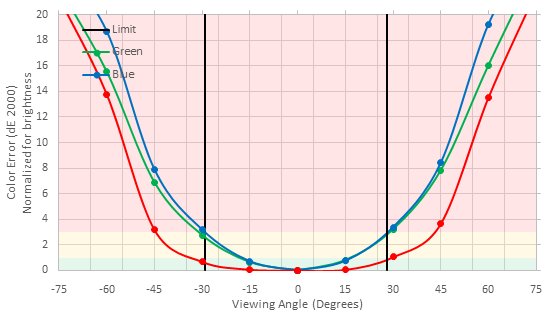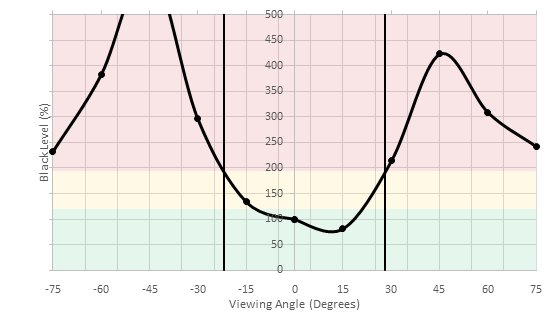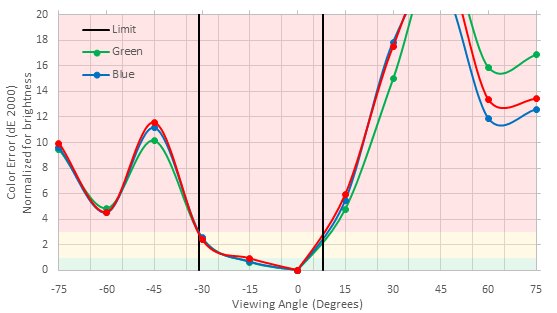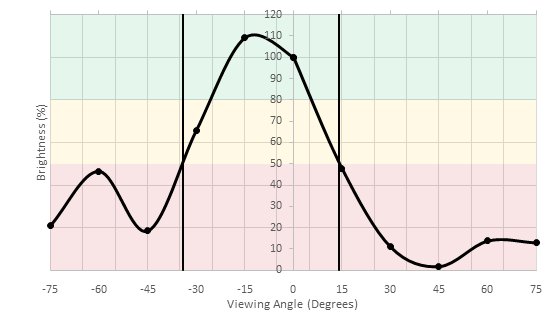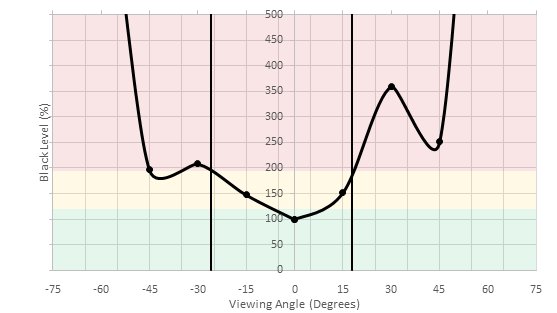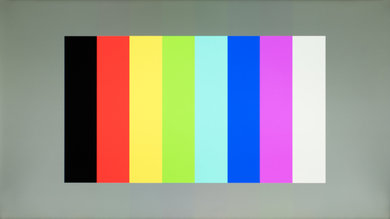The AOC AG271QX is a good 2560x1440 gaming monitor with a high 144Hz refresh rate and TN panel. It has excellent motion handling due to the fast response time and support for FreeSync. It also has very low input lag which is excellent. Unfortunately, the picture quality is below average and when viewed from up close, the edges of the screen lose accuracy due to the narrow viewing angle.
Our Verdict
Good for mixed usage. The picture quality is below average. However, this is made up for with excellent motion handling and input lag due to the 144Hz refresh rate and support for FreeSync. Unfortunately, the image degrades rapidly when viewed at an angle and the sides lose accuracy when viewed from up close.
-
144Hz refresh rate feels very responsive
-
Input lag is excellent
-
Edges of the screen appear nonuniform due poor viewing angle
-
Low native contrast ratio
Decent monitor for office use. The AOC Agon AG271QX gets bright to overcome reflections, which is great. It also has a light-matte finish which handles direct glare well. The 1440p resolution is also comfortable for working on 1 or 2 windows at a time. Unfortunately, the edges of the screen look non-uniform due to the poor viewing angles and the image quality is below average.
Great choice for gaming. The AOC AG271QX feels extremely responsive due to the high native refresh rate and low input lag. The monitor also supports FreeSync to adjust the refresh rate to the game, which is great and removes screen tearing. Unfortunately, it can't flicker the backlight to clear up motion further and the picture quality is sub-par.
Decent monitor for watching movies and TV shows. The monitor handles reflections well due to great screen brightness and light-matte finish. Color accuracy is also decent out of the box. Unfortunately, the image degrades rapidly when viewed at an angle and the contrast ratio is sub-par.
Decent for creating media such as editing photos or videos. The monitor handles surrounding light well due to the light matte finish and can get bright to overcome glare. Unfortunately, it doesn't support the wider Adobe RGB color space and the image loses accuracy when viewed at an angle. The picture quality of the TN panel is also worse than average.
Doesn't support HDR. Also, the AOC AG271QX doesn't support HDR features such as a wide color gamut, and can't get bright. For an HDR gaming monitor, see the Samsung CHG70.
- 7.5 Mixed Usage
- 7.4 Office
- 8.4 Gaming
- 7.2 Multimedia
- 7.4 Media Creation
- 5.8 HDR Gaming
Changelog
Check Price
Differences Between Sizes And Variants
We tested the 27" model with a 144Hz TN panel and FreeSync (AG271QX). There are many more variants of AOC Agon Gaming monitors with differences in resolution, size, refresh rate and adaptive sync support which are described in the table below.
If someone comes across a different type of panel or if AOC AGON AX271QX doesn't correspond to our review, let us know and we will update the review. Note that some tests such as the gray uniformity may vary between individual units.
| Model | Size | Resolution | Refresh rate | Panel Type | Adaptive Sync |
|---|---|---|---|---|---|
| AG241QX | 24" | 2560x1440 | 144Hz | TN | FreeSync |
| AG241QG | 24" | 2560x1440 | 165Hz | TN | G-Sync |
| AG251FZ | 25" | 1920x1080 | 240Hz | TN | FreeSync |
| AG271QX | 27" | 2560x1440 | 144Hz | TN | FreeSync |
| AG271QG | 27" | 2560x1440 | 165Hz | IPS | G-Sync |
| AG271UG | 27" | 3840x2160 | 60Hz | IPS | G-Sync |
| AG352UCG | 35" | 3440x1440 | 100Hz | VA | G-Sync |
Compared To Other Monitors

While the AOC Agon AG271QX is a good monitor for mixed usage, it is focused on fast-paced gaming with high refresh rate, FreeSync support, and low input lag. For other uses, there may be better or cheaper monitors available. See our recommendations for the best gaming monitors for PC, the best 1440p monitors and the best gaming monitors for Xbox One X.
These are two different types of monitors, each with their advantages and disadvantages. The Acer Predator XB271HU Bmiprz is a G-SYNC compatible monitor that has wider viewing angles, so the image remains accurate when viewed from the side. The Acer also has better ergonomics, so you can position it to your liking with ease. If however, you have a dark room and sit straight in front, the FreeSync compatible AOC AGON AG271QX has more uniform blacks and a faster response time that leaves only a small blur trail behind fast-moving content.
The AOC AGON AG271QX is better than the ASUS PB277Q. The AGON AG271QX is a gaming-oriented monitor and has a much higher native refresh rate, so fast motion looks much smoother. The AOC also has better dark room performance with a higher native contrast ratio and better black uniformity.
The AOC AGON AG271QX and the Dell S2417DG have very similar performance. Both support variable refresh rate implementations. The S2417DG supports G-SYNC and the AG271QX supports FreeSync. The Dell also supports black frame insertion (BFI) through the NVIDIA ULMB, which can help clear persistence blur. It also has better ergonomics that make it easy to position the monitor to your liking, whereas the AOC AGON has a larger screen size which makes it more comfortable to work on.
The AOC AGON AG271QX is a bit better than the Dell S2719DGF. The AOC AGON AG271QX has much better black uniformity and thus less backlight bleed in very dark scenes in a dark room. The Dell S2719DGF, on the other hand, has slightly better ergonomics which can be helpful depending on your setup.
The AOC AGON AG271QX is a bit better than the HP OMEN X 25f. The AOC has a slower refresh rate, but this has very little impact on the overall appearance of motion. The AOC has better ergonomics, as it can swivel, and can be rotated to portrait orientation. The AOC also has a higher resolution screen and more screen area, so it's a bit better for multitasking and allows you to see more fine details in your favorite games.
The AOC AGON AG271QX is much better than the MSI Optix G27C. The AOC AGON has much better ergonomics, making it easier to place it in the most comfortable position. The AGON displays gradients with almost no banding and has a very fast response time, so motion looks crisp with very little blur trail. The higher resolution of the AGON makes it easier to get more done or to see more fine details in games.
The Samsung CHG70 is better than the AOC AGON AG271QX. The Samsung has better native contrast than the AG271QX, important for dark room viewing, although the AG271QX has better black uniformity. The AG271QX has a slightly faster response time, but the CHG70 has an optional black frame insertion feature that can improve motion by reducing persistence blur. Finally, the CHG70 supports HDR and can display a wide color gamut.
The AOC AGON AG271QX is better than the Dell U2717D for most users, unless you need a wider viewing angle. The AGON AG271QX has much better motion handling, with almost no motion blur and a fast refresh rate, with very little input lag. The IPS panel in the U2717D has a wider horizontal and vertical viewing angle, good for wall mounting or sharing your work with someone, but it has worse dark room performance.
The AOC AGON AG271QX is marginally better than the Dell S2716DG. The AG271QX has better black and gray uniformity which is great if your work involves a lot of web browsing or photo editing. The AOC AGON AG271QX also has a remarkable gradient with no visible banding. The Dell S2716DG, on the other hand, has an option to introduce flicker so as to make the image crisper.
The ASUS ROG Swift PG279Q is much better than the AOC AGON AG271QX. The PG279Q has much better viewing angles and an optional black frame insertion feature for even clearer motion. The AG271QX has better gradient handling, and there is almost no banding in areas of similar color.
The AOC AGON AG271QX is better than the HP OMEN 27. The AOC AGON AG271QX has better ergonomics and this is very useful no matter the usage. It also has better black uniformity that improves the quality of blacks in a dark room. On the other hand, the HP supports the black frame insertion feature that helps reduce blur during fast action.
The AOC AGON AG271QX is slightly better than the ViewSonic XG2402. The AG271QX is better at displaying large areas of similar color, as it supports 10-bit color. However, the main advantage of the AGON AG271QX is the larger, higher resolution screen, that makes it much easier to see fine details in games and for multitasking.
The ASUS PG279QZ is better than the AOC AGON AG271QX for most people. The ASUS is an IPS monitor with much better viewing angles whereas the AOC has a TN panel with almost instantaneous response time and better black uniformity. The ASUS PG279QZ has better ergonomics and a BFI option to make the image crisper.
The Gigabyte AORUS AD27QD is much better than the AOC AGON AG271QX. The AORUS supports HDR, which is great, and has much wider viewing angles. The AD27QD also has an optional black frame insertion feature, which can help reduce persistence blur. The AGON has better black uniformity and a slightly faster response time, but this likely isn't noticeable. The AGON also has more inputs and supports older analog inputs from DVI and VGA cables.
The AOC AGON AG271QX is slightly better than the MSI Optix MAG271CQR. The AGON has better ergonomics, better black uniformity, and much better gradient handling. The MSI Optix has an optional black frame insertion feature.
Test Results
The design of the AOC AGON AG271QX is excellent. The monitor looks sleek from any angle, and the low profile V-shaped stand supports it well. It is very easy to adjust orientation or height for comfort, and the hook for hanging headphones adds extra convenience. The monitor does stick out a bit from the stand though, so it can't be placed very close to a wall. The build quality feels great due to the quality metal parts.
The AOC AGON AG271QX monitor does not have a local dimming feature. The video is for reference only.
The peak brightness is great and doesn't depend on the window size so all content looks equally bright.
HDR is not supported.
The horizontal viewing angle is poor but fairly typical for a TN panel. When viewed from even a small horizontal displacement, the contrast drops dramatically due to the raising black level and drop off of brightness. All of the colors shift also. When viewed from up close, the sides of the monitor appear washed out. If you need better viewing angles, take a look at the BenQ EX2780Q.
The vertical viewing angle of this AOC AG271QX monitor is bad. This is as expected with a TN panel, however, it results in a non-uniform screen due to the different angle to each point on the screen when viewed from up close.
The gray uniformity of the AOC AG271QX is very good, which is great for browsing web-pages or playing media or sports without any dirty screen effect. The uniformity issues visible in the photo are a result of the narrow viewing angles, which causes different sides of the screen to appear slightly different colors.
The dark gray (5%) gray uniformity is even better, and shouldn't cause issues when viewing dark scenes.
The black uniformity of this monitor is below average. This results in dark games or movies appearing blotchy. The sides are also a bit darker than the center, and the top appears a bit darker than the bottom. This is in part due to the poor viewing angle.
Out of the box and with the 'Standard' picture mode, the monitor has a below average accuracy. The white balance dE and color dE are both between 3.5 and 4, which at this level of inaccuracy, is noticeable for most enthusiasts out there. The gamma is also well under our 2.4 target that we aim for and the curve is not tracking closely at all our target curve, as you can see on the gamma picture.
If you don't really intend to calibrate your monitor, the AOC AG271QX does not really have 'Picture Mode' per say, but instead many 'Eco Mode' and 'Color Temp.' settings. The best 'Eco Mode' setting is the 'Standard' mode since only this mode gives you control over the 'Contrast' and 'Brightness' settings. For the 'Color Temp.' setting, you can choose from many color temperature available and select the one that you feel is the best for you. If you want to have manual control over the each of the RGB value, then you will need to set it to 'User'.
After the calibration process, the AOC AGON AG271QX has an excellent accuracy. The white balance dE was brought down to 1.27 and the color dE was brought down to 1.31. This level of inaccuracy is mostly perceivable by professionals who are used to work with a calibrated monitor and should be good for most enthusiasts. The gamma is now more close to our 2.4 target and the curve is also tracking our target curve much more closely than before.
You can download our ICC profile calibration here.
Good color gamut. While the monitor cannot cover the standard s.RGB gamut completely, it reproduces enough of it to display saturated colors and relatively accurate content. Its Adobe RGB coverage is a bit limited though, so it isn't the best choice for more professional use.
The AOC Agon AG271QX is able to fill most of the sRGB color volume. It isn't able to cover deep blacks or dark colors due to the low native contrast ratio but otherwise performs well. In the wider Adobe RGB color space, it isn't able to reproduce the more saturated colors, especially in the green areas.
HDR gamuts are not supported as the monitor only supports SDR.
HDR color volumes are not supported as the monitor doesn't support HDR.
Overdrive Off
Overdrive Weak
Overdrive Medium
Overdrive Strong
Like most monitors, the AOC Agon AG271QX doesn't flicker and instead, shows each image for a full frame. The absence of flicker makes motion appear slightly smoother but results in some persistence blur as objects are followed between frames. It is not possible to use Black Frame Insertion (BFI) to add flicker and help reduce persistence blur. This is unfortunate as flicker is useful to clear up motion even further with fast paced content, such as action or fighting games.
The monitor has a high native refresh rate of 144Hz. Freesync on this monitor can adjust the screen's refresh rate to match the frame rate of a compatible graphics card, which allows playing graphically-intensive games with significant framerate drops without tearing or stuttering. This is one of the best 144 Hz monitors we've reviewed in 2018.
Update 01/15/2019: We have tested the AG271QX with NVIDIA's new FreeSync drivers, and there were no issues. G-Sync could be enabled from the NVIDIA Control Panel, and the monitor was completely tear-free for the entire FreeSync range.
The input lag of the AOC AG271QX is excellent, as expected for a gaming-targeted monitor. The input lag at 60Hz is a bit longer, however, this is due to the longer scan out time and so is expected. The FreeSync input lag is roughly equal to the input lag at native resolution, which is great.
This Agon monitor provides great screen real estate due to the quad HD resolution and above average screen size.
This monitor has a few additional features, such as the quick settings toggle (pictured here) and options to adjust the overdrive when gaming or to increase shadows in dark areas.
Comments
AOC AGON AG271QX: Main Discussion
Let us know why you want us to review the product here, or encourage others to vote for this product.









